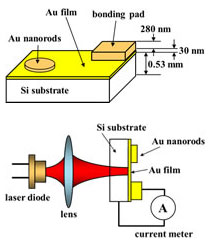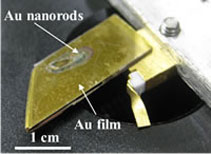| Mar 22, 2011 | |
High efficiency infrared photodetectors using gold nanorods |
|
(Nanowerk News) Toyohashi Tech researchers develop an innovative infrared photodetector exploiting 'plasmon resonance' at the surface of gold nanorods, which enhances the density of photoelectrons excited over the Schottky barrier. This technology shows potential as the basis for the development of high efficiency infra-red photodetectors for optical communications systems.
 Figure 1: Device structure Devices used for the detection of light and other forms of electromagnetic energy include calorimeters, superconducting devices, and photodiodes used in optical communications systems. Now, typical semiconductor devices include Schottky barrier photodetectors—where a PN junction is not necessary. However, for optical communications systems applications, it is necessary to improve the photo detection efficiency in the 1.3~1.5 micrometer range of wavelengths. Here, Mitsuo Fukuda and colleagues used the localized surface plasmon (LSP) effects exhibited by gold nano-rods to improve the optical response of Schottky photodiodes. Notably, the desired resonance wavelength can be obtained by appropriate choice of the dimensions of gold nanorods. Thus combining Schottky barriers with gold nanorods holds promise as a means of producing high efficiency photodiodes.  Figure 2: Experimental set-up Fig. 1 shows the structure and dimension of the gold nanorod Schottky diode photodetector, where 10 nm x 100 nm gold rods were used. Fig .2 shows the experimental set up and Fig. 3 the experimental results for light of 1500 nm, showing a significant increase in the photocurrent of the device with the gold nano rods. |
| Source: Toyohashi University of Technology |
